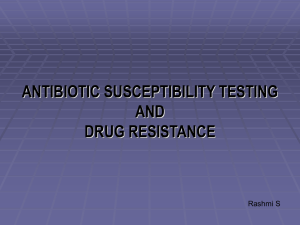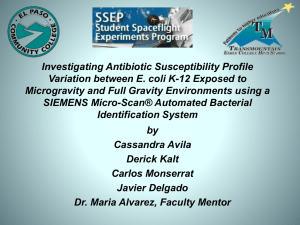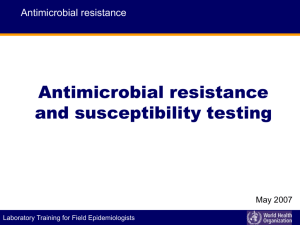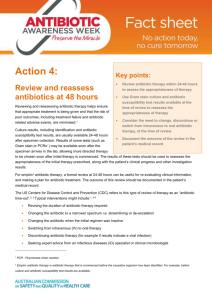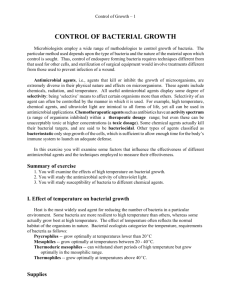Lecture 2 – Week 7 Control of Microbial Growth
advertisement
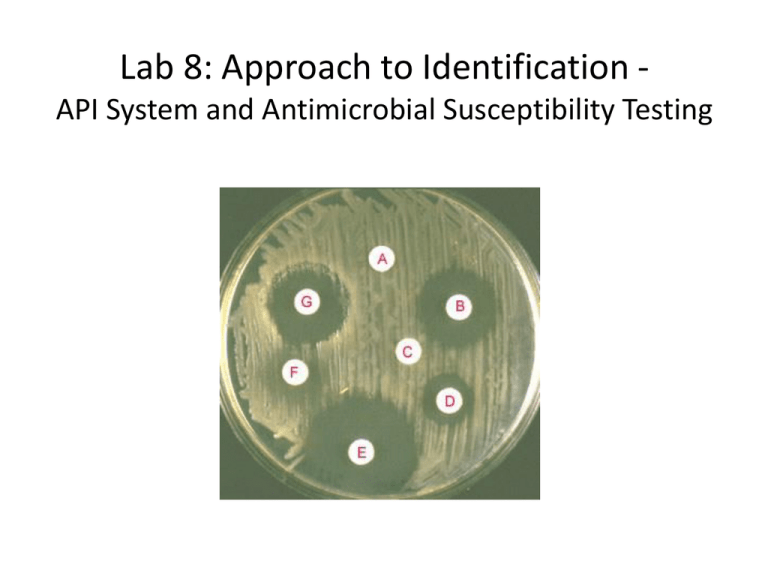
Lab 8: Approach to Identification API System and Antimicrobial Susceptibility Testing Microorganism Identification Recall how many tests are done to identify Gram Negative Rods (below). Wouldn’t it be convenient if there was a one-step system for all of these tests? Rapid Identification Systems: API 20E • The API 20E system is a multiple test system allowing the determination of 20 different biochemical tests simultaneously. • Most commonly used to identify gram-negative bacteria like E.coli, Salmonella, and Shigella. See pgs 105-111 Antimicrobial Susceptibility Testing: The Kirby-Bauer Method • Antimicrobial is a general term for something that inhibits or kills microbes. • An antibiotic is a type of antimicrobial that is made by microbes to kill or inhibit other microbes. • Very few antibiotics are effective against all types of bacteria (most are effective against either gram positive OR gram negative bacteria). Antimicrobial Susceptibility Testing: The Kirby-Bauer Method • Antibiotics are produced by metabolic reactions of bacteria and fungi. • Most antibiotics produced come from 2 bacterial strains, Streptomyces and Bacillus, and the fungi Penicillium. Penicillium Antimicrobial Susceptibility Testing: The Kirby-Bauer Method • This lab technique asks the question “Which of these drugs stops the spread of this particular strain of bacteria?” • The procedure is designed to evaluate the susceptibility of a pathogen to assorted antibiotics. • Disk diffusion test uses a Petri plate of agar (Mueller-Hinton) inoculated with bacteria over entire surface. Paper disks with standard concentration of antibiotic is placed on the agar. • Zone of inhibition: inhibition of bacterial growth around the antibiotic disk. Zone of inhibition Antimicrobial Susceptibility Testing: The Kirby-Bauer Method Minimum inhibitory concentration (MIC): the concentration of antibiotic at the edge of the disk zone of inhibition. MIC is determined by comparing the zone of inhibition to MIC standards in a table (pg 116). Susceptible: zone size indicates antibiotic is effective for treatment. Intermediate: zone size indicates antibiotic is moderately effective for treatment. Resistant: zone size indicates antibiotic is ineffective for treatment. Antibiotic Susceptibility Test: Part 1 Pages 114-116 Antibiotic Susceptibility Test: Part 1 Antibiotic Susceptibility Test: Part 1 Assignments for this week Lab Reports: • API: PRE-LAB questions 1-3 • Kirby Bauer Lab: chart and questions 1-4 Lab Smart (reminder): • Identification of Unknown Bacteria Available Oct 21st, Due Nov 17th Antibiotic Susceptibility Test: Part 2 Antibiotic Susceptibility Test: Part 2 Antibiotic Susceptibility Test: Part 2
